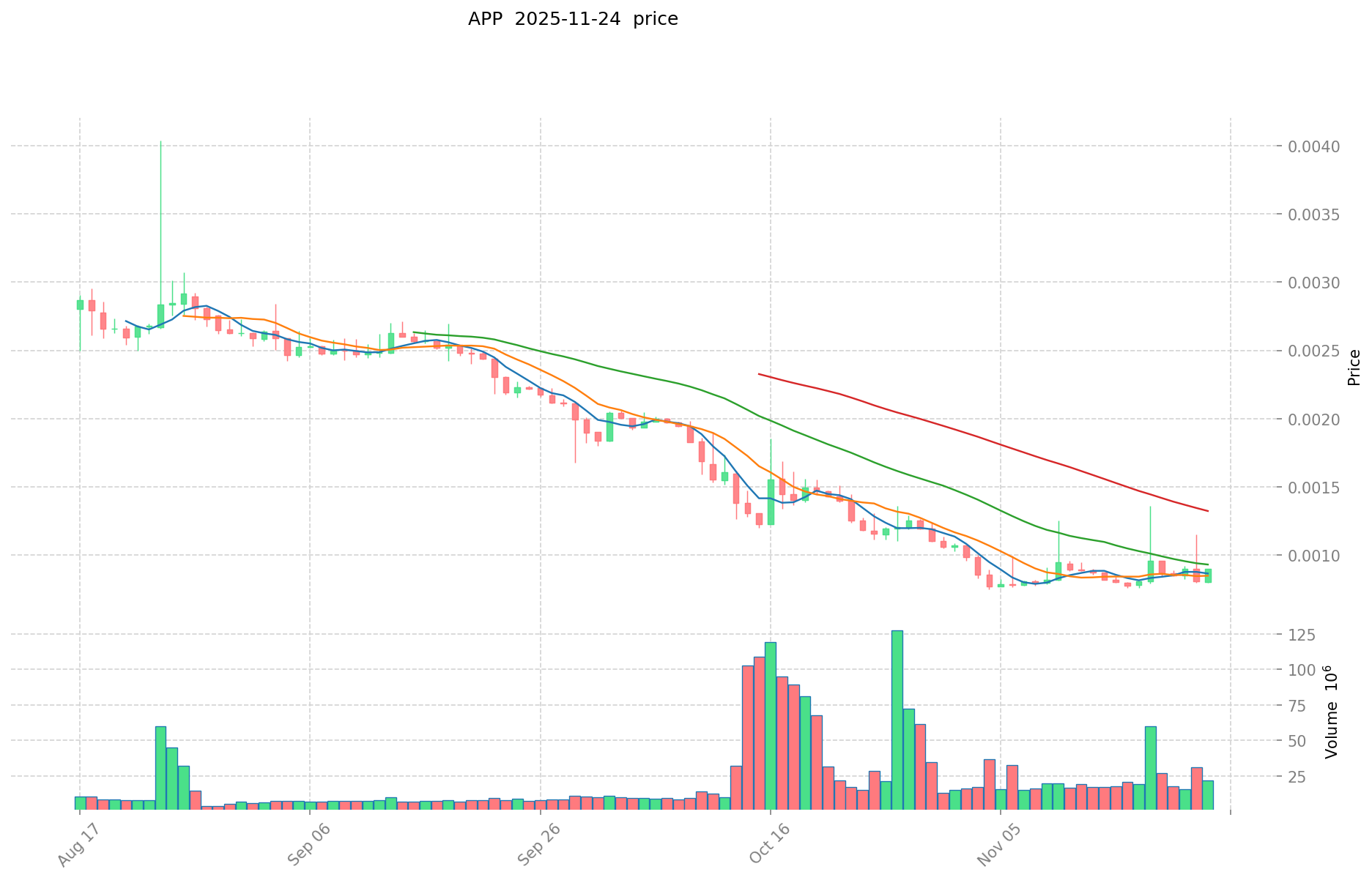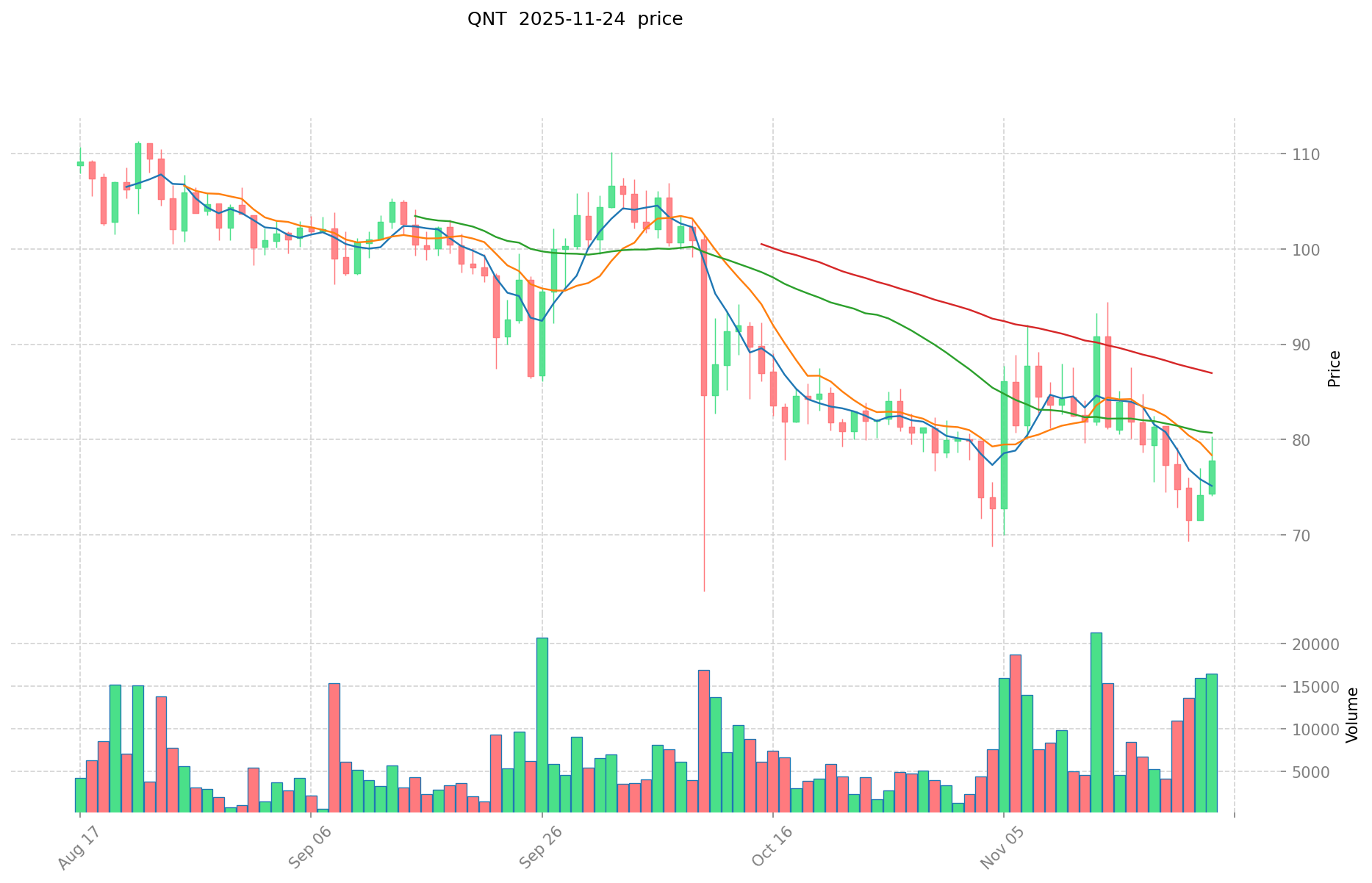APP vs QNT: Which Cryptocurrency Has More Growth Potential in 2023?
Introduction: Investment Comparison of APP vs QNT
In the cryptocurrency market, the comparison between RWAX (APP) vs Quant (QNT) remains an unavoidable topic for investors. The two not only show significant differences in market cap ranking, application scenarios, and price performance, but also represent distinct positioning in the crypto asset space.
RWAX (APP): Since its launch, it has gained market recognition as an Injective-focused launchpad superapp with advanced on-chain trading bots.
Quant (QNT): Introduced in 2018, it has been hailed as a technology provider enabling trusted digital interaction, recognized for solving interoperability through its global blockchain operating system, Overledger.
This article will comprehensively analyze the investment value comparison between RWAX and Quant, focusing on historical price trends, supply mechanisms, institutional adoption, technological ecosystems, and future predictions, attempting to answer the question investors care about most:
"Which is the better buy right now?" Here is the analysis based on the provided template and information:
I. Price History Comparison and Current Market Status
RWAX (APP) and Quant (QNT) Historical Price Trends
- 2024: APP experienced significant volatility due to market speculation, with price fluctuations ranging from $0.000747 to $0.051.
- 2024: QNT was impacted by overall crypto market trends, with price movements between $77.05 and $427.42.
- Comparative analysis: During the recent market cycle, APP dropped from its all-time high of $0.051 to a low of $0.000747, while QNT showed more stability, maintaining a price range between $77 to $427.
Current Market Situation (2025-11-24)
- APP current price: $0.0008949
- QNT current price: $77.05
- 24-hour trading volume: APP $18,712 vs QNT $775,747
- Market sentiment index (Fear & Greed Index): 19 (Extreme Fear)
Click to view real-time prices:
- Check APP current price Market Price
- Check QNT current price Market Price


Key Factors Affecting APP vs QNT Investment Value
Supply Mechanism Comparison (Tokenomics)
- QNT: Native token used for licensing fees and accessing services within the Overledger network. It features inherent demand as enterprises use it to develop multi-chain applications (mDApps).
- APP: Information about supply mechanism not available in the provided references.
- 📌 Historical pattern: As blockchain technology develops and security improves, tokens with practical utility in business applications tend to experience sustained value growth.
Institutional Adoption and Market Applications
- Institutional Holdings: QNT appears to have adoption potential across various industries, from finance to other sectors, though specific institutional holders aren't detailed.
- Enterprise Adoption: QNT is positioned for enterprise use in developing multi-chain applications, offering cross-industry utility and practical business applications.
- Regulatory Attitudes: Information about regulatory perspectives on either token not specified in the references.
Technical Development and Ecosystem Building
- QNT Technical Development: Built on the Overledger network, enabling multi-chain applications and interoperability between different blockchains.
- APP Technical Features: Associated with smart quantitative trading systems that offer automated processes from data collection to strategy execution, with capabilities including real-time market data processing, advanced factor analysis, and AI-driven market sentiment analysis.
- Ecosystem Comparison: QNT focuses on enterprise blockchain solutions and interoperability, while APP appears oriented toward trading platforms with emphasis on user experience and platform credibility.
Macroeconomic Factors and Market Cycles
- Performance in Inflationary Environments: Technological innovation in blockchain, optimization of scaling solutions, and security improvements provide strong support for the value growth of cryptocurrencies like QNT.
- Monetary Policy Impact: Specific impacts of interest rates or dollar index not detailed in the references.
- Geopolitical Factors: Information not specified in the provided references.
III. 2025-2030 Price Prediction: APP vs QNT
Short-term Prediction (2025)
- APP: Conservative $0.000758352 - $0.0009028 | Optimistic $0.0009028 - $0.001336144
- QNT: Conservative $41.5908 - $77.02 | Optimistic $77.02 - $103.977
Mid-term Prediction (2027)
- APP may enter a growth phase, with estimated prices ranging from $0.001168728768 to $0.0015063615232
- QNT may enter a consolidation phase, with estimated prices ranging from $77.54816465 to $106.865153725
- Key drivers: Institutional capital inflow, ETF, ecosystem development
Long-term Prediction (2030)
- APP: Base scenario $0.00188688922136 - $0.00256616934105 | Optimistic scenario $0.00256616934105+
- QNT: Base scenario $141.340147850849062 - $175.261783335052837 | Optimistic scenario $175.261783335052837+
Disclaimer: The above predictions are based on historical data and market analysis. Cryptocurrency markets are highly volatile and subject to change. This information should not be considered as financial advice. Always conduct your own research before making investment decisions.
APP:
| 年份 | 预测最高价 | 预测平均价格 | 预测最低价 | 涨跌幅 |
|---|---|---|---|---|
| 2025 | 0.001336144 | 0.0009028 | 0.000758352 | 0 |
| 2026 | 0.00147770304 | 0.001119472 | 0.00085079872 | 25 |
| 2027 | 0.0015063615232 | 0.00129858752 | 0.001168728768 | 45 |
| 2028 | 0.002075662291968 | 0.0014024745216 | 0.001206128088576 | 56 |
| 2029 | 0.002034710035937 | 0.001739068406784 | 0.00128691062102 | 94 |
| 2030 | 0.00256616934105 | 0.00188688922136 | 0.001075526856175 | 110 |
QNT:
| 年份 | 预测最高价 | 预测平均价格 | 预测最低价 | 涨跌幅 |
|---|---|---|---|---|
| 2025 | 103.977 | 77.02 | 41.5908 | 0 |
| 2026 | 98.643365 | 90.4985 | 75.113755 | 17 |
| 2027 | 106.865153725 | 94.5709325 | 77.54816465 | 22 |
| 2028 | 144.026801650875 | 100.7180431125 | 80.57443449 | 30 |
| 2029 | 160.307873320010625 | 122.3724223816875 | 77.094626100463125 | 58 |
| 2030 | 175.261783335052837 | 141.340147850849062 | 100.351504974102834 | 83 |
IV. Investment Strategy Comparison: APP vs QNT
Long-term vs Short-term Investment Strategies
- APP: Suitable for investors focused on trading platforms and quantitative strategies
- QNT: Suitable for investors interested in enterprise blockchain solutions and interoperability
Risk Management and Asset Allocation
- Conservative investors: APP: 10% vs QNT: 90%
- Aggressive investors: APP: 30% vs QNT: 70%
- Hedging tools: Stablecoin allocation, options, cross-currency portfolios
V. Potential Risk Comparison
Market Risk
- APP: High volatility due to market speculation
- QNT: Potential fluctuations based on overall crypto market trends
Technical Risk
- APP: Platform stability, algorithm reliability
- QNT: Network scalability, security vulnerabilities
Regulatory Risk
- Global regulatory policies may have differing impacts on both tokens
VI. Conclusion: Which Is the Better Buy?
📌 Investment Value Summary:
- APP advantages: Advanced trading bots, focus on user experience
- QNT advantages: Enterprise adoption potential, interoperability solutions
✅ Investment Advice:
- Novice investors: Consider QNT for its more established market presence
- Experienced investors: Diversify between APP and QNT based on risk tolerance
- Institutional investors: Explore QNT for potential enterprise blockchain applications
⚠️ Risk Warning: The cryptocurrency market is highly volatile. This article does not constitute investment advice. None
VII. FAQ
Q1: What are the key differences between APP and QNT? A: APP is focused on being an Injective-based launchpad superapp with advanced trading bots, while QNT is a technology provider enabling interoperability between different blockchains through its Overledger network. APP caters more to trading platforms, while QNT targets enterprise blockchain solutions.
Q2: Which token has shown more price stability? A: Based on the historical data provided, QNT has demonstrated more price stability compared to APP. While APP experienced significant volatility ranging from $0.000747 to $0.051, QNT maintained a more consistent price range between $77.05 and $427.42.
Q3: What are the main factors driving the value of QNT? A: The main factors driving QNT's value include its utility in enterprise blockchain solutions, potential for institutional adoption, and its role in enabling interoperability between different blockchains through the Overledger network.
Q4: How do the supply mechanisms of APP and QNT compare? A: The information provided does not detail APP's supply mechanism. For QNT, it serves as the native token for licensing fees and accessing services within the Overledger network, with inherent demand as enterprises use it to develop multi-chain applications (mDApps).
Q5: What are the long-term price predictions for APP and QNT by 2030? A: By 2030, the base scenario for APP predicts a price range of $0.00188688922136 - $0.00256616934105, with an optimistic scenario above $0.00256616934105. For QNT, the base scenario predicts $141.340147850849062 - $175.261783335052837, with an optimistic scenario above $175.261783335052837.
Q6: How should investors allocate their portfolio between APP and QNT? A: For conservative investors, a suggested allocation is 10% APP and 90% QNT. For aggressive investors, the suggestion is 30% APP and 70% QNT. However, investors should adjust these ratios based on their own risk tolerance and market research.
Q7: What are the primary risks associated with investing in APP and QNT? A: For APP, the main risks include high volatility due to market speculation, platform stability, and algorithm reliability. For QNT, risks involve potential fluctuations based on overall crypto market trends, network scalability issues, and security vulnerabilities. Both face regulatory risks as global policies may impact their operations differently.
Share
Content